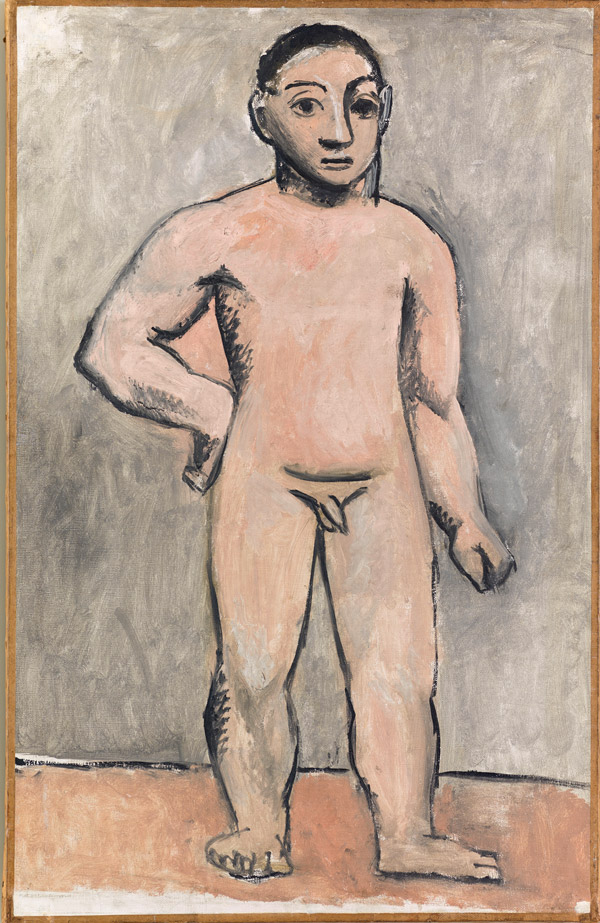Picasso’s Experimentation of Cézanne’s Doubts : Fifteen Ways “to go into the Motif”
Picasso liked to say that Cézanne “was the father of us all”,[1] where “us all” referred to the artists who, at the start of the 20th century, wanted to revolutionize painting so that it ceased to represent and began to present, leaving the mimetic task to photography.
On October 23, 1906, three months after Picasso’s journey to Gósol, Cézanne died of pneumonia, right one year before of the great retrospective of his work at the Salon d’Automne in Paris. Before that, Picasso “had long been conversant with Cézanne’s work”;[2] he had already seen tens of original Cézannes in the successive Salons d’Automne since 1904, in the backroom of Vollard’s gallery (Vollard was Cézanne’s and subsequently, Picasso’s art dealer)[3] and at the Stein’s home. His prodigious visual memory retained these works as the mind retains a piece of cryptic learning that is still awaiting its moment of emergence and lucidity.
I assert that this moment was the trip to Gósol in the summer of 1906, although Picasso did not devote himself to painting the Pedraforca Mountain (the main mountain at Gósol and the most impressive mountain in Catalonia) as Cézanne painted Mount Sainte-Victoire. As I have already discussed, this influence is not usually acknowledged by other specialists, who normally take for granted that in the summer of 1906 Picasso was rather submerged in a sort of Gauguinian primitivism.[4] However, it is my understanding that the Gauguinian aspect remained basically in the Blue and Rose Periods. From the first attempts to create[5] the Portrait of Gertrude Stein, Gauguin no longer provided any solution and Picasso decided, intellectually driven by Gertrude, to follow in Cézanne’s anxious steps.[6] This obliged him to adopt the skeptical ideal of a programmatic abandonment of any established habit, dogma or customary gesture.
Nothing could be further from the dogma than Cézanne’s plastic options, which were built from permanent doubt and in a process of unending reflection; with him, painting learned to show its own failures in a sort of negative dialectic often seen in the most advanced modern painting.[7] Cézanne claimed to be the primitive bringer of a new art, and he achieved this with little fuss, simple gestures and small canvasses. Away from Parisian first Modernism in his native Provence, easel in hand and wielding his brushes, he asked nature for its simplest forms: the cylinder, the sphere, and the cone. His originality, unlike Manet’s, had the roughness of a return to the origin, or to the perception primordiale (primordial perception), as Merleau-Ponty calls it; this is probably the best term to define what the so-called artistic primitivism means in Cézanne’s and Picasso’s creative process,[8] why Cézanne considered himself as the primitive of a new art and how his method worked like a mantra: only though the repetition of gestures could perfection of the simple form be achieved. Within this new understanding, the oils would no longer be works – opera, finished works – but events in an infinite search, like that of Frenhofer[9] (Cézanne’s chosen alter ego, who was also chosen by Picasso in his mature years).
[1] See Christian Zervos, “Conversation avec Picasso,” in Cahiers d’art, special issue (1935): 173–8, in Bernadac and Michael (Eds.), Propos: 31–6; Daniel–Henry Kahnweiler, “Entretiens avec Picasso au sujet des Femmes d’Alger”, Aujourd’hui 4 (September 1955), in Bernadac and Michael (Eds.), Propos, 70–4; Brassaï, Conversations avec Picasso (Paris: Gallimard, 1964: 104), in Bernadac and Michael (Ed.), Propos: 104–14 and 148–54, see specifically 148–9; François Gilot and Carlton Lake, Life with Picasso, (New York : McGraw-Hill Book Company, 1989 [1964]), 68–71; Helène Parmelin, Picasso dit…. (Paris: Gontier, 1966), 66; André Verdet, “Picasso et ses environs” in Entretiens, notes et écrits sur la peinture. Braque, Léger, Matisse, Picasso (Paris: Ed. Galilée, 1978): 140–1. On certain occasions, Picasso referred to Cézanne as “a mother who protects her children” (quoted by Brigitte Léal in “Le parfum du marbre lointain de la Sainte-Victoire,” in Billoret-Bourdy and Guérin (Eds.), Picasso Cézanne, 56-60; Michel Guérin, “Réalisation et démiurgie”, in Billoret-Bourdy and Guérin (Eds.), Picasso Cézanne: 16).
[2] Richardson, A life of Picasso, Vol II, 52.
[3] Among the paintings by Cézanne owned by Vollard and that Picasso saw in 1904 was Mardi gras (1881), which had a big influence on the scenic dimension of the paintings in Gósol. The relation between Vollard and Cézanne is discussed in: Rebecca A. Rabinow (Ed.), Catalogue Cézanne to Picasso. Ambroise Vollard, Patron of Avant-garde (New York – Paris: The Metropolitan Museum of Art, The Art Institute of Chicago and Musée d’Orsay, Yale University Press and Réunion des Musées Nationaux, 2007). Actually, Vollard’s influence on Picasso’s Cézannian education became crucial, as shown by Anne Roquebert in “De Cézanne a Picasso. Chez Vollard” in Billoret-Bourdy and Guérin (Eds.), Picasso Cézanne, 31–41.
[4] Richardson, A Life of Picasso, Vol II: 52.
[5] It is very exciting to see these first attempts in the x-rays taken of the portrait’s face, see Tinterow and Alison (Eds.), Picasso, 115.
[6] On Picasso referring to “Cézanne’s anxiety” see: Zervos, Bernadac and Michael (Eds.), Picasso, 178. See also Éric Bonnet, “Écrire et détruire les figures”, in Billoret-Bourdy and Guérin (Eds.), Picasso.: 45–54, especially 49. About Stein’s intellectual influence making Picasso turn to Cézanne, see Madelaine, “Preface”, Gertrude Stein, Pablo Picasso, 9–11.
[7] Gertrude Stein even affirmed that: “All modern painting is based on what Cézanne had failed to do, instead on what he nearly succeeded in doing. To show what he could not achieve had become Cézanne’s obsession and that of his followers” (text cited in Harold Acton, More memoirs of an Aesthete [London: Methuen, 1970), 175.
[8] Merleau-Ponty, Sens et non-sens, 20
[9] In 1937, Picasso moved to the same place in which Balzac establishes Frenhofer’s address, see Ludmila Virassamynaiken, “La lutte d’amour”, in Billoret-Bourdy and Guérin (Eds.), Picasso Cézanne: 135–48, see specifically 144–5.





 Summary
Summary